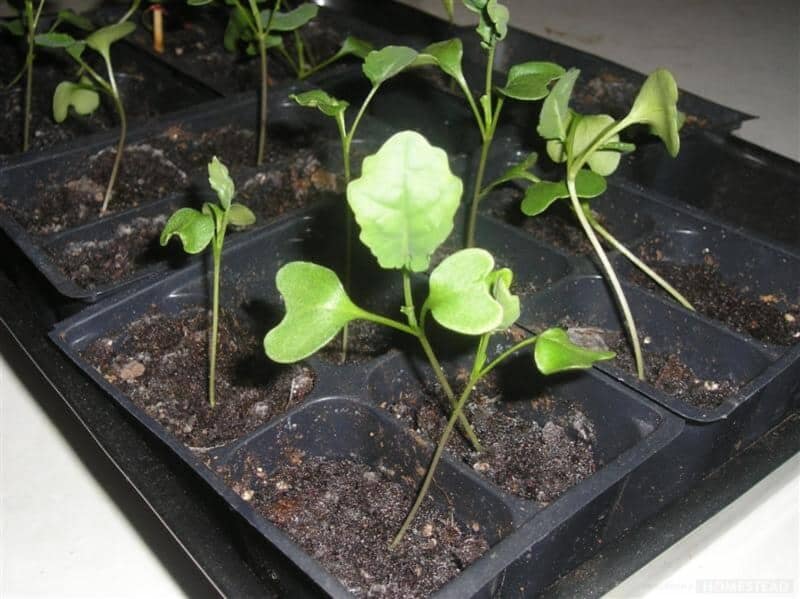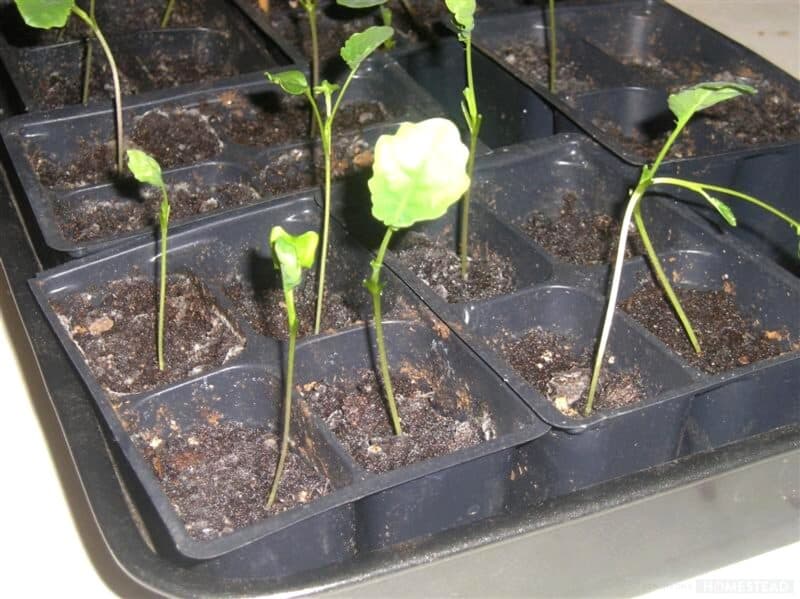One of the most important things you can do for your seedlings is to pinch them back. Pinching back helps to encourage bushier, fuller growth, and it also helps to prevent leggy seedlings.
When you pinch back a seedling, you are essentially removing the growing tip, which encourages the plant to produce more side shoots. As a result, your seedlings will be sturdier, and better able to withstand wind and rain.
In addition, pinching back also helps to promote more even growth, which can be especially helpful if you are growing vegetables or other plants that need to be a certain size at maturity.
So don’t be afraid to give your seedlings a little pinch – it just might be the key to a bountiful harvest!
Ready to learn more? Here’s what I’ve learned about pinching off seedlings so you can decide whether it’s right for you.
Table of Contents:
What Does it Mean to Pinch Plants?
Pinching plants is a common gardening technique that helps to encourage full, bushy growth. The process involves removing the growing tip of the plant, typically with your forefinger and thumb or a pair of scissors.
This stunts the plant’s growth and causes it to produce more lateral or side branches. As a result, the plant becomes fuller and more compact. Pinching also encourages plants to produce more flowers and fruits.
While it may seem counterintuitive, pinching actually helps plants to grow healthier and stronger. So, the next time you’re looking to promote full growth in your plants, don’t be afraid to give them a pinch.
When Should I Pinch Back Seedlings?
As a general rule of thumb, seedlings should be pinched back when they have several sets of true leaves, not counting the cotyledons.
Pinching back too early can delay flowering and fruiting, so it is important to wait until the plant has achieved a fair amount of growth before taking any action.
With most plants, it is best to pinch back in the evening hours, as this minimizes stress on the plant. After pinching back, be sure to water the plant well and keep an eye out for any signs of distress. Done properly, pinching back can help promote full, bushy growth in your plants.
Why Should I Pinch Back Seedlings?
When you pinch back seedlings, you are actually helping the plant to grow fuller and healthier. By removing the growing tip of the plant, you force it to produce more stems, resulting in a denser and more compact plant.
This is especially beneficial for leafy greens and herbs, as it results in larger, more desirable leaves. In addition, pinching back seedlings can also help to improve fruit production.
By keeping the plant compact, you allow for better air circulation and more light to reach the fruit, resulting in larger, higher quality fruit.
Furthermore, pinching back can also help to stagger bloom time, ensuring a continuous supply of fresh produce throughout the season. So next time you’re starting your garden, don’t forget to give your seedlings a little pinch!
How to Pinch Back Seedlings
Here are a few tips to help you pinch back seedlings successfully.
Wait for the Right Timing
One of the most important things to remember when pinching back seedlings is to wait for the right time. Pinching too early can damage the plant and inhibit its growth, while waiting too long can result in a leggy, unruly plant.
As a general rule of thumb, it’s best to wait until the plant has several sets of leaves before pinching back. This will give the plant a chance to develop strong roots and stems before being stunted by pinching.
Find the Right Spot
When you are pinching back seedlings, it is important to find the right spot.
You want to make sure that you are cutting back the plant so that it will branch out and become fuller. To find the right spot, look for a node, which is a bump on the stem where leaves and branches grow. Cut the stem just above the node.

See the heart shaped leaves at either side of the larger, center leaf? Those are the first leaves. And they gotta go.
It’s easy. All you do is use your fingernail to cut the first leaves from the stem. Or you can use scissors, if you want. Just don’t yank or tear them off, as this might uproot your tender seedlings.

Pinching back seedlings encourages them to branch out, which makes for a fuller plant. It also helps to prevent leggy growth. When seedlings are pinched back at this spot, they send out new growth from the leaf nodes, which results in a bushier plant.
Use Sterile Scissors or Pruners (or Your Hands!)
When ready to pinch, use your fingers or a sharp pair of scissors to snip off the top half of the plant, just above a set of leaves. Be sure not to damage the leaves themselves, as this can also inhibit growth.
When you pinch, you can use your fingers or a pair of scissors – as mentioned – or even a pair of pruners. Whatever you do, make sure the tools are sanitized and your hands are clean so you don’t spread diseases to your plants.
More Tips for Pinching Back Plants
Here are a few more tips to follow.
Don’t Damage the Buds
When it comes to pinching back plants, it is important to be careful not to damage the buds.
Although it may seem like a minor thing, damaging the buds can actually cause significant harm to the plant. The buds are where the new growth occurs, so if they are damaged, the plant will be unable to produce new leaves or flowers. In addition, damaged buds are also more susceptible to disease and pests.
Repeat Pinching When New Leaves Form
When new leaves form on a seedling, they should be pinched off in order to encourage the plant to produce more leaves. This will result in a fuller, healthier plant. Pinching also helps to prevent leggy growth, as it encourages the plant to put more energy into producing new leaves rather than growing tall and thin. When pinching, it is important to only remove the new growth; if too much is removed, it can damage the plant.
Pinch Outside Growth to Limit Overall Growth
Pinching isn’t just for seedlings!
Once a plant has reached its desired size, it is important to pinch back the outside growth to limit the plant’s overall growth. This will encourage the plant to put more energy into developing its roots, rather than its leaves and stems.
Pinching back should be done regularly, as it can prevent a plant from becoming too leggy or scraggly. When pinching back, it is important to use sharp shears or scissors in order to make a clean cut.
Otherwise, the plant may develop an unsightly brown scar. With regular pinching, it is possible to keep a plant healthy and compact, without compromising its root system.
Which Types of Plants Benefit Most from Pinching?
The practice of pinching is often used to encourage bushier growth in plants. By removing the tips of stems, pinching stimulates the plant to produce more lateral shoots or side shoots. As a result, the plant becomes fuller and more compact.
While this technique can be used on many different types of plants, some species are more responsive than others.
Late-season flowering perennials, such as asters, chrysanthemums, and Veronica, are particularly well suited for pinching. Flowering annuals, such as impatiens and zinnias, also respond well to this type of treatment. In addition, many common herbs, such as basil and sage, can benefit from being pinched back.
Some other plants that benefit from this include:
- Helenium
- Russian sage
- Sedum
- Phlox
- Coleus
- Cosmos
- Petunias
- Geraniums
- Salvia
- Snapdragon
- Verbena
- Zinnia
- Lavender
- Oregano
- Rosemary
- Tarragon
- Larkspur
- Dahlias
- Fuchsias
- Cockscomb
- Tomato plant
- Pepper plants (including pepper seedlings)
- Campanula
- Sunflowers
- Marigolds
- Sweet peas
What Plants Should You Avoid Pinching?
Resist the urge to pinch plants with one flower per stem or low-to-the-ground leaves. Thyme is an example.
If you pinch these plants, you could inadvertently remove the only flowers they’ll produce for the year. Specific examples include astilbe, columbine, daylily, delphinium, dianthus, heuchera, hosta, hydrangea, iris, peony, and phlox.
Additionally, avoid pinching if you want seeds and blossoms for local pollinators or want plants to go to seed.
Besides Pinching, How Else Can I Cut Back Plants?
If you want to keep your plants looking their best, it’s important to know how to properly trim them. Pinching isn’t your only option! Deadheading, pruning, and shearing can also be helpful.
While deadheading and pruning are both effective ways to remove unwanted growth, they serve different purposes. Deadheading is typically used to tidy up a plant by removing spent flowers or seed heads.
Pruning, on the other hand, is usually done to promote new growth or control the shape of a plant. Shearing is another option for shaping plants, but it should be used sparingly as it can damage the plant if done improperly.
With a little practice, you can keep your plants looking neat and tidy all season long.
And here they are all pinched off! Yes, they look bare now, but don’t worry, your plants will thank you for helping to lighten the load.
Pinching off the seedlings’ tips can help them grow in a straighter, more robust manner. If you have any seedlings or plants that could use this method of growth encouragement, give it a try!
Once the true leaves have begun to grow, pinch off the first set of leaves so the plant’s energy is focused on true growth!

A city girl learning to homestead on an acre of land in the country. Wife and homeschooling mother of four. Enjoying life, and everything that has to do with self sufficient living.

Good information, thanks!
Thanks so much for the tip! Last fall was my first season to attempt gardening, so I still have much to learn! I’m also guessing I’m getting a late start, as I haven’t ordered OR planted any seeds yet. Gotta get busy!
Thank you so much, I am starting my first seeds today and I love the advice! Does the same go for herbs?
Umm… I’m trying to think of the different herbs I’ve grown… I don’t remember any of them having a first set of leaves, and then true leaves coming in. I’d say, as a rule of thumb, anything that has a first set of leaves, and then different looking “true” leaves which grow in soon after, should have the first leaves pinched off. If you don’t see two distinctly different looking sets of leaves, don’t worry about pinching anything off.
Another tip, though, is to trim things like onions and garlic seedlings when their tops get long and scraggly, leaving about 2 in. to grow.
advice that i always need reminded of lol
i have a little something for you at my blog
Boy, I could have used this last year! Thanks for posting! 🙂
Thanks for the tip. I never knew that this needed to be done and have wondered why my seedlings started getting lanky and falling over.
I’d never heard that. Maybe that’s why I have so much trouble starting plants from seeds. Thank you!
Thanks for the reminder Kendra! Just getting our seedlings in for a head start. Can’t wait for planting season – with the warmer than average winter we have been getting a jump start on some garden prep. Happy Planting Season! 🙂